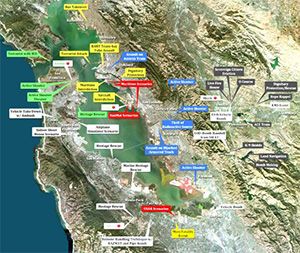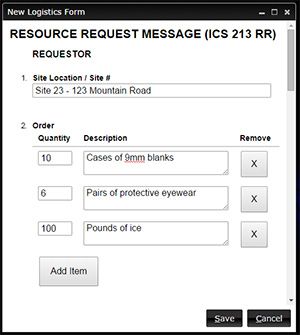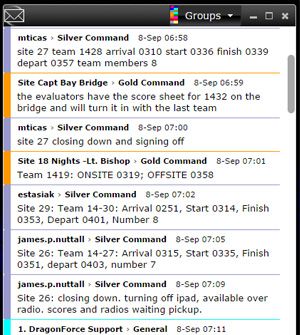Urban Shield, hosted by the Alameda County Sheriff’s Office (ACSO), is a full-scale regional preparedness exercise assessing the overall Bay Area UASI Region’s response capabilities related to multi-discipline planning, policies, procedures, organization, equipment and training. The 48-hour event includes a variety of scenarios that are designed to train, test and assess tactical teams, as well as all first responders, to prepare for and provide a unified response to disasters and major emergencies. At Urban Shield 2014, Drakontas’ DragonForce command and control, team collaboration application was used to provide communications and the overall common operating picture for the Area Commands as well as key departments including: logistics, transportation, technology and EMS team evaluation.
The Urban Shield event area covers more than 1000 square miles (see Figure-1) and is comprised of 60 event sites organized under 8 area commands all reporting to a central incident command at the ACSO Department Operations Center (DOC). The transportation and logistics departments are responsible for moving the participant teams and supplies to the various sites during the 48-hour event.

DragonForce is a command & control, team collaboration application that runs on smartphones, tablets and web browsers. DragonForce provides an integrated set of communication and collaboration tools that establish a common operating picture for teams of users. DragonForce capabilities include: personnel tracking, file sharing, secure text messaging, incident reporting / digital forms, and a unique collaborative whiteboard capability that allows teams of users to draw together on maps, floor plans or pictures.
More than 400 DragonForce accounts were provisioned for Urban Shield area command staff as well as transportation and logistics operators and support personnel. The following DragonForce features were heavily utilized at Urban Shield 2014:
Multi-Group Support – DragonForce can support the simultaneous operation of multiple groups or teams of users. This allows each operational group to focus on the messages, files and locations associated with their respective team. Supervisory personnel can be members of multiple groups so that they have situational awareness for the entire event space. Twenty (20) DragonForce groups were operational during Urban Shield.
Digital Forms – Logistics requests and fulfillment status tracking, technology evaluations, EMS team and participant scoring and evaluation were all completed via
DragonForce forms. More than 1000 forms were processed during the 48-hour event.
Figure-2: Logistics Form
Figure-3: Text Messaging


Text Messaging – DragonForce Text messaging served as the primary communication channel between the various Area Commands. A continuous stream of more than 2,800 updates, reports and alerts were monitored and logged during the event greatly freeing up radio communications.
DragonForce color codes the text “feeds” from the various groups and allows a user to filter the desired information feeds coming from the various groups for which they are a member. (See Figure-3)
User Alias – In addition to a user name (which is immutable) each DragonForce user can be assigned an “alias” to describe their identity or role more explicitly. A user’s alias may be updated at any time. This feature was extremely useful in the Urban Shield environment where many of the 400 DragonForce users do not know one another. For example, the transportation team van drivers included the names of the teams they were driving in their alias. This association enabled all DragonForce users to track and communicate with the teams as they made their way through the event space.
Personnel Tracking – Each of the 35 team drivers and all area commanders were equipped with a Samsung Android tablet provisioned with DragonForce. These tablets, plus several hundred personal smartphones (both Android and iOS), produced more than 320,000 location reports of Urban Shield personnel.
Whiteboarding – This feature was most heavily used during the 9-month planning phase of Urban Shield 2014. The various event sites were noted on the map and each site was pre-planned with icons and annotations indication the event site boundaries, parking and staging areas as well as the positioning of lights, tents and portable restroom facilities.
File Sharing – Pictures or files placed in a DragonForce group are automatically distributed to all members of that group. This feature was used to distribute traffic, safety, weather and security reports to the various Area Commands and departments. It was also used by the various mobile users to collect and share photographs of activities at the various sites.
Summary Facts:
- 413 DragonForce user accounts provisioned
- 270 simultaneous users during peak DragonForce usage
- 20 DragonForce Groups provisioned to support Area Commands and key departments
- 1,000+ Digital forms / situation reports processed
- 2,800+ text messages sent
- 320,000+ location reports logged
Key Findings:
To be effective a shared situational awareness application must be: easy to access and use in a high stress environment; provide utility and value to justify its continued use; and be reliable. Most DragonForce users were provided minimal to no formal training to run the application, receiving an email with their username and password and instructions on how to download the DragonForce app from the Play/App stores online to their smartphones.
“Thank you for all of your support during Urban Shield 2014 and making our training exercise a huge success. The DragonForce software worked flawlessly and provided many of our units real time situational awareness.”
Captain Garrett Holmes – Incident Commander, Urban Shield 2014

